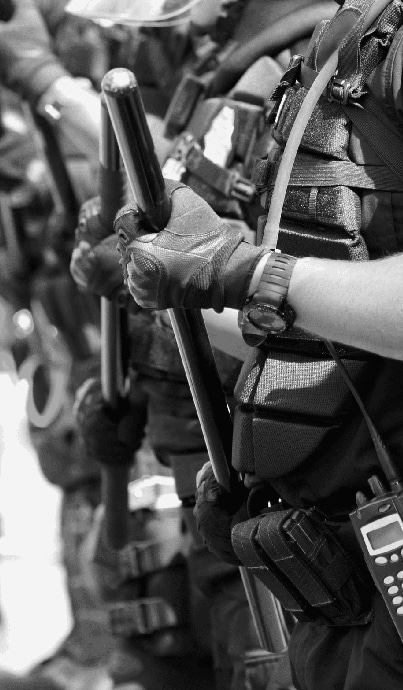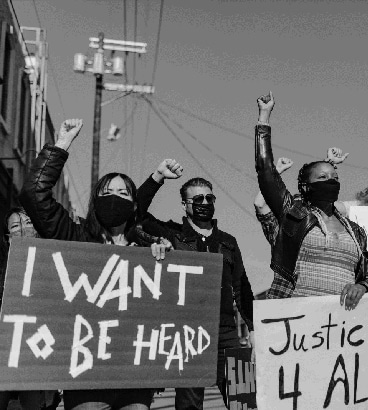Protesting vs. Rioting
As political demonstrations become more common in response to national and international incidents, knowing the difference between protesting vs. rioting is increasingly essential. The First Amendment safeguards individuals’ right to peacefully assemble and express dissent but does not protect rioting, which involves violent crime. At Police Brutality Center, we protect the public’s right to demonstrate peacefully. We help individuals take action when officials violate those rights and provide education to assist citizens in demonstrating legally.
Were you or a loved one a victim of police brutality?
Attorneys that work with Police Brutality Center may be able to assist you.
"*" indicates required fields
Content Last Updated: October 14, 2025
Political demonstrations and protests have been a part of U.S. civil life since before our nation began. These actions seem to have become more prevalent in recent years, as movements like Black Lives Matter have brought inequality and injustice into public focus.
Many U.S. residents remember the death of George Floyd, a 46-year-old Black man who died at the hands of officers in Minneapolis, Minnesota, in 2020. Floyd’s death sparked countless protests and riots amid the pandemic, encouraging Americans to raise their voices about police misconduct and excessive force.
As more and more people exercise their constitutional right to dissent, it’s important to be aware of the legalities regarding such events, including the distinction between protesting vs. rioting.
What Is a Protest?
The U.S. legal system generally defines a protest as a public demonstration of dissent against a government’s actions or policies. Some protests express dissatisfaction with a lack of action, such as the failure of law enforcement agencies to hold officers accountable for brutality.
Protests are peaceful acts of civil resistance, expressing mass disagreement with the authorities’ choices. Most protests are organized events that an individual or group has planned, scheduled, and publicized to encourage participation.
There are many different kinds of protests. Some, such as rallies and marches, are large and often loud gatherings where participants can vocally express disapproval. A vigil is a quieter and more solemn form of protest.
The U.S. Constitution protects the right of groups to assemble peacefully. The First Amendment explicitly states:
Congress shall make no law…abridging ….the right of the people peaceably to assemble, and to petition the Government for a redress of grievances.
Groups throughout U.S. history have used their right to protest to make a difference. The 1963 March on Washington pushed the federal government to enact the Civil Rights Act of 1964 and the Voting Rights Act of 1965. In 2017, the Women’s March spurred a record number of women to run for and win federal office.


What Is a Riot?
Not all public demonstrations are peaceful. By legal definition, riots are public disturbances involving acts of violence. In a riot, the violent activity happens as part of a group assembly and causes injury or property damage. An assembly involving threats of violence may also count as a riot if the threat is realistic.
Federal law prohibits individuals from using interstate or foreign commerce, including methods of communication such as television or telephone, to organize or participate in a riot. Known as the Anti-Riot Act, this measure was passed by Congress as part of the Civil Rights Act of 1968.
Any riot participation can also subject someone to felony or misdemeanor charges, depending on the circumstances and degree of damage. Federal and state laws contribute to the nature of the charge and its penalties.
Additionally, many violent crimes can occur during a riot. In 1992, the Los Angeles race riots sparked acts of arson and looting. Participants in the 2021 attack on the U.S. Capitol received charges of assault, destruction of property, and theft.
What Is the Difference Between Protests and Riots?
Protests and riots are public demonstrations of dissatisfaction. Both may begin with the goal of expressing objection to the status quo, but the nature of that expression makes up the difference between protesting vs. rioting.
A protest is peaceful, organized, and controlled. There is no purposeful violence or destruction of property.
A riot disturbs the peace and involves violent crime. There is violent or destructive intent, whether or not that intent was present at the event’s outset. Even if a demonstration began as a peaceful protest, it may turn into a riot.
When Does a Protest Become a Riot?
A protest becomes a riot when the crowd loses control, and the peaceful demonstration becomes violent. The legal definition of a riot only requires one or more individuals, part of a group of three or more, to choose or threaten violence that harms another person or their property.
By this definition, a single act of violent aggression may turn a protest into a riot, even if other members of the assembled crowd choose not to engage.
A ranking police official is usually the person who determines whether the assembly has become a riot. If such an official determination happens, the police department may order the crowd to disperse. Any individual who remains after such an order is potentially guilty of a misdemeanor.
What Is the Appropriate Force to Stop a Riot?
Under U.S. Department of Justice policy, officers should use the minimum force necessary to restore safety and regain control of a situation. Force is justified only when “no effective, safe, and feasible alternative appears to exist,” and a reasonable officer facing similar circumstances would use the same force level.
Officers learn to follow the use-of-force continuum, which escalates from zero to lethal force. The full continuum includes:
- Officer presence: No force, the preferred method
- Verbal commands: Non-threatening and calm but firm instructions
- Empty hand control: Use of bare hands to restrain if possible or strike if necessary
- Less lethal alternatives: Weapons designed to subdue but not kill
- Deadly force: Firearm use, only for when a suspect poses a significant violent threat
Force levels may be equal to or greater than the threat, depending on what officers deem necessary. Unnecessary levels of force may qualify as police brutality, which activists and attorneys across the country are taking action to stop.
What To Do if Stopped by Police During a Riot
Remember that the police department’s responsibility is to restore peace. If an officer stops you during a riot or protest, remain calm and avoid arguing, disobeying, or obstructing police action. Leave the scene if the police officer confirms you may do so.
If you are exercising a peaceful right to protest, you may say so, citing your First Amendment rights. Should the officer put you under arrest, exercise your right to remain silent and contact an attorney.
What Are the Legal Considerations of Protests and Riots?
The First Amendment protects an individual’s fundamental right to protest, but states and cities may enact laws about how, where, and when protests may happen. For instance, several states have penalties for protesting near oil and gas pipelines, which these states deem to be critical infrastructure. Check the U.S. Protest Law Tracker for updated information on protest laws in your state.
Obeying state, federal, and local laws is the wisest course of action for individuals seeking to protest legally. You may bring a camera to film suspected police misconduct, provided you obey the laws in your state. Some states restrict where and how citizens may film on-duty officers.
Local leaders also have a responsibility to protect public safety. During periods of civil unrest, elected officials can discourage violence by calling for calm protests. Officials who fail to voice their opinions may unknowingly encourage riots.


Protecting the Right of Americans to Protest
Despite the gray areas in protesting vs. rioting, the Constitution protects your right to protest. If you have participated in a peaceful protest and believe law enforcement has violated your rights, Police Brutality Center can connect you with experienced civil rights attorneys.
Contact us today to get legal help.
